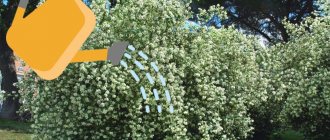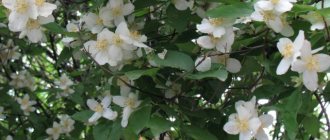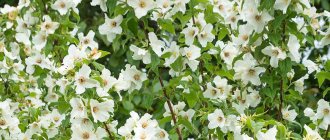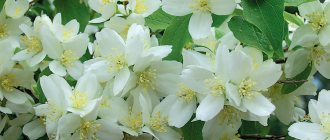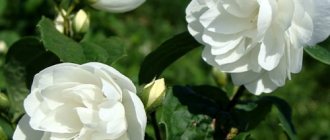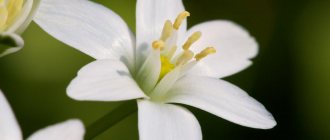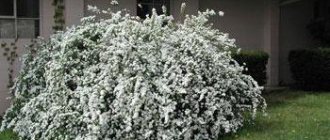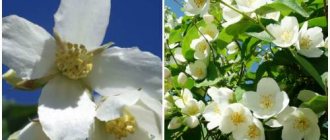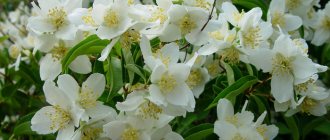What is mock orange and how does it grow?
The Latin name of the mock orange, Philadelphus, comes from the Greek words “love” and “brother”, because the shoots of the bush are located opposite and close to each other. According to another version, the name of the deciduous shrub was given in honor of one of the kings of Ancient Egypt, Ptolemy Philadelphus.
Mock orange belongs to the Hydrangeaceae family. Botanists know more than 60 species of this plant growing in the wild. No more than half of all varieties of garden jasmine are cultivated.
What does mock orange look like?
All types of mock orange are similar in basic parameters. These are shrubs ranging in height from one to three meters with closely spaced opposite shoots. Its leaves are roundly elongated, sometimes pointed, small (5 - 7 cm), more often smooth, but also have jagged edges.
The bark of the plant is predominantly gray. In some types of jasmine it is brownish. In most varieties, the bark darkens on the shoots of the second year of life. For some completely, for others only at the base. The bark peels off on mature shoots.
Flowering of garden jasmine begins in late spring and lasts from a month to two. Its flowers are simple, white, from two cm in diameter, collected in inflorescences from 3 to 9 pieces, bloom on short side branches of the shoot. Most types of mock orange, or garden jasmine, as it is often called, have a delicate aroma. But there are also species without odor. In varietal hybrid varieties, the inflorescences can consist of double flowers and reach a size of more than 10 cm.
Blooming mock orange (jasmine) photo:
The mock orange fruit is not large. The capsules, consisting of several chambers, are filled with small achenes.
In nature, mock orange grows in regions with warm and temperate climates (north of the American continent, East Asia, Europe). The culture prefers the edges of deciduous or mixed forests. It is often found on rock slides and cliffs. Bushes grow one by one or in groups.
How fast does mock orange grow?
Gardeners classify garden jasmine as a fast-growing shrub. It only takes 2 - 3 years from the moment of planting for the height and size of the mock orange crown to reach the maximum for its variety.
Application of mock orange
Jasmine is universal in landscape design. Single bushes perfectly decorate garden gazebos and look original against the background of brick and stone walls of a house and other buildings. Due to the rapid growth of shoots, mock orange is suitable for creating hedges of various heights.
Photo of a single planting of a mock orange bush:
Creating layering and dividing the bush
These propagation methods are less reliable than cuttings; the level of rooting of young plants formed using these methods hardly exceeds 50%.
However, if a gardener decides to propagate a plant using these methods, he should carry out the process in the same steps as with any other shrubs: mock orange does not require special conditions.
Types of mock orange with photos and descriptions
Garden jasmine varieties must be carefully selected for growing conditions. Some of them are not suitable for frosty Russian winters. And although most species quickly grow back after sanitary spring pruning of frostbitten shoots, the main characteristics of mock orange are worth studying before purchasing a seedling.
Ordinary
In nature, this type of garden jasmine grows in the southern regions of Western Europe and the Caucasus. The three-meter shrub blooms earlier than other representatives of the glorious family. Pale or common mock orange (Philadelphus pallidus) is distinguished by bare, erect shoots. The leaves of the bush are pointed, with sparse small jagged edges. Their upper side is dark green, and the lower side is much lighter and covered with fluff. Milky-white simple small flowers, up to 3 cm, flowers collected in brushes of up to 7 pieces each.
The common mock orange became the progenitor of several forms and varieties of shrubs: large-flowered, golden, willow-leaved, double, silver-edged, low.
The hybrid varieties of pale mock orange Virginal, Belle Etoile and Bicolor are very popular among gardeners.
Coronary
The southern European newcomer has taken its rightful place in gardens around the world. Selection of this variety of garden jasmine began in the 16th century.
A bush up to 3 m in height forms a lush crown - up to 2 m in diameter. Even young shoots are covered with exfoliating bark of a red-brown and yellowish hue.
The leaves are deep green, oblong and pointed. Their reverse side is pubescent with veins. Fragrant inflorescences, consisting of 3 - 5 simple creamy-white flowers, cover the bush for 3 - 4 weeks, starting from the 5th year of life.
Philadelphus coronarius (Latin version of the name) is one of the longest-living representatives in its family. According to the description and photo, the crowned mock orange in nature can reach an age of 80 years. Moreover, it blooms for at least 30 seasons.
Breeders have worked a lot on the oldest type of jasmine. Many varieties have been created that differ in flower structure and other characteristics. Among the most famous hybrids, gardeners note Innocence, Variegatus and Aureus.
Fluffy
This type of garden jasmine got its name because of the airiness of the lower leaves. Layered brownish bark covers the shoots only from below. Lush cups of snow-white flowers, collected in inflorescences (7-10 pieces each), are almost odorless. The shrub blooms by mid-summer. This is one of the late-blooming mock oranges.
This type of mock orange became the basis for the creation by Russian breeders of many varieties: Ballet of Moths, Zoya Kosmodemyanskaya, Unusual Pearl, Academician Korolev.
And although hybrids were bred several decades ago, they are still popular among gardeners.
small-leaved
Not only small leaves of about 2 cm are a distinctive feature of garden jasmine. The photo of mock orange does not convey its main feature - its unique strawberry aroma. Gardeners often call this species Strawberry.
A small (1.5 m) bush has an equally compact crown. Simple flowers are arranged singly or in small inflorescences. The bush usually blooms actively. It is covered with a snow-white blanket so much that its erect shoots bend, forming a cascade.
Based on small-leaved jasmine, amazingly beautiful hybrids Snow Avalanche, Ermine Mantle and Avalange were created.
Hybrid
This category includes many interspecific combinations that were created by breeders around the world. Among the most popular varieties, gardeners note French hybrids bred by Lemoine and Russian hybrids by Academician Vekhov, many of which received their own names.
Flower of the hybrid mock orange shrub Minnesota Snowflake in the photo:
By crossing various natural species of mock orange, new varietal characteristics were obtained. The main achievements were the production of two-color varieties of garden jasmine, increasing the flowering period and frost resistance of the crop.
Odorless
One of the tallest shrubs in the genus of garden jasmine. It reaches a height of 4 m, and its crown diameter is about 3 m. The plant is distinguished by long and lush flowering. But its main feature is the absence of aroma. Four- and five-petalled simple flowers are collected in brushes of up to 5 pieces. Their leaf blades are very long for mock oranges. On non-flowering shoots they can be up to 12 cm.
Lemoine
As a result of selection by the French originator Lemoine, the first hybrid with increased frost resistance and unique decorative qualities was developed. Currently, there are about 40 hybrid varieties of garden jasmine from the Lemoine workshop. Most of them are low-growing, reaching a height of no more than 1.5 m. At the same time, the crown of the bushes quickly grows to the same size.
The flowers of French mock orange hybrids are striking in their diversity. Among them there are terry varieties and two-color ones. Shrubs and foliage differ. Oval, ovate and pointed leaves can range from light green to soft golden color. The most popular varieties: Dame Blanche, Snow Avalanche, Avalanche Mont Blanc, Belle Etoile, Pyramidal.
Lemoine was the first breeder who managed to create mock orange with white and purple flowers. Natural specimens have only white or cream inflorescences.
Schrenk
This tall mock orange received its name in honor of the famous Russian scientist and traveler Alexander von Schrenck. In nature, the shrub is found in the Far East and neighboring countries.
The shrub grows up to 3 m in height. The bark on its young shoots is brownish and covered with hairs. But from the second year of life it begins to crack and crumble. In this case, the color changes to grayish-brown.
The leaves of Schrenk's mock orange are ovate and slightly narrowed at the upper edge. Flowering shrub in early June in central Russia. Small (up to 4 cm) flowers with a delicate aroma are collected in clusters of 9 pieces.
Growing rules
Mock orange with the scent of strawberries is quite unpretentious. But if you water, fertilize, prune and spray the bush from pests in time, it will look well-groomed and will be able to bloom longer.
Watering schedule
Strawberry mock orange requires watering, especially during flowering and on hot summer days. During these periods, the plant requires weekly and sometimes even daily watering: up to 3 buckets of water per bush. Drooping leaves indicate a lack of moisture.
Weeding, loosening, mulching
It is recommended to loosen the soil to provide air access to the mock orange roots after each watering. In addition, it is important to regularly weed the soil in the root circle. Mulching helps retain moisture in the soil and also prevents weeds from actively germinating.
Feeding schedule
When planting strawberry mock orange, fertilizer is added to the soil, and then for a couple of years the shrub will easily tolerate the absence of fertilizing. Every spring, when the buds bloom, it is recommended to water the garden jasmine with a bucket of mullein in a ratio of 1:10. For mock orange, you can also use another nitrogen fertilizer: immediately after flowering, wood ash is poured under the bush. It is added during loosening, and then the plant is watered.
Mineral fertilizers are used after 3 years of cultivation. In spring, the shrub is fed with urea, potassium sulfate and superphosphate, and after flowering - with potassium sulfate.
Trimming
First of all, it is necessary to prune frozen, as well as diseased and damaged shoots every spring. After flowering, a bush is formed, removing excess growth and faded tops of branches. After pruning, 10-15 branches are left on the Strawberry mock orange, on which young shoots with buds will soon begin to appear. The secret is that flowers form more abundantly on last year's strong shoots.
Anti-aging pruning of mock orange is carried out once every few years, before the start of sap flow - in the spring, and sanitary pruning - in the fall, as necessary. The bush will bloom longer if its branches are pinched.
Preparing for winter
In autumn, the soil in the root zone is mulched with a thick layer of sawdust. The shrub does not tolerate low temperatures. But since the Strawberry mock orange bush is small, it is convenient to cover it in winter. Even if the tips of the shoots are damaged by frost, after pruning the plant will regain its strength quite quickly. The bush can be bent to the ground, or simply covered with special material or spruce branches.
Advice! Frost is especially dangerous for young shoots: to prepare them for winter, it is recommended to pinch their tops, thus stopping growth. This should be done in August.
The best varieties of mock orange
Among the many types and varieties of garden jasmine, you can choose a shrub for your garden that is ideal for its decorative qualities and growing conditions.
Fragrant varieties of mock orange
Most natural varieties of mock orange are fragrant. But breeders have enhanced this quality. If you need garden jasmine with a scent for your garden, then you should pay attention to the varieties Lemoine and Vekhova.
- Snow Avalanche is a miniature French hybrid (up to 1.2 m) that blooms from the end of June. Its tiny flowers emit a strong strawberry scent. The fragrance lasts about 2 weeks.
- Bouquet Blanc - called the White Bouquet. Terry inflorescences with a sweet aroma cover an almost two-meter bush for 3 weeks.
- Gletscher - blooms with double snow-white flowers for almost a month. Large inflorescences emit a scent similar to that of jasmine.
- Alabaster - combines double and single flowers during flowering. Their aroma is strong and pleasant.
- Airborne assault - surprises with drooping colors, similar to parachute domes in the sky. The aroma of this unique variety is strawberry, with a hint of exotic fruit.
- The miniature varieties of the Vekhov selection, Gnome and Dwarf, speak for themselves. From 50 to 80 cm in height, compact bushes emit a unique aroma when flowering.
The most beautiful varieties of mock orange
It is difficult to argue about tastes, especially when it comes to such beautiful plants as mock oranges. Each hybrid is beautiful in its own way. Some are covered with double flowers, while others have an attractive petal shape or flower structure. And the height of splendor are varieties with two-tone colors. After all, absolutely all types of mock orange naturally bloom white or slightly creamy.
- Few people will be indifferent to the Salut variety. A shrub more than 2 m tall during flowering is strewn with inflorescences consisting of fairly large double flowers of a creamy-white color.
- The shoots of Komsomolets are slightly curved upward. Large (up to 4.5 cm) inflorescences cover the bush with a snow-white blanket. Flowers have an interesting structure. The lower petals are rounded and shorter than the upper ones. And the thin inner petals are enveloped by pale yellow stamens.
- Belle Etoile, or Beautiful Star, is a hybrid of the French Lemoine, which bears its name for good reason. The shrub has snow-white simple flowers with a purple center and yellow stamens. Flowering lasts about a month.
- Ballet of Moths is beautiful with its simple asymmetrical colors. During flowering, this lush, powerful shrub has almost no foliage visible.
- Bicolor - distinguished by large, about 5 cm, flowers. Its distinctive feature is the middle burgundy-pink color, against which the yellow delicate stamens stand out brightly.
- Schneeshturm is considered the furriest hybrid. Its flowers - very large and double - cover a three-meter bush for a month.
You can list the unusually beautiful varieties of mock orange for a long time, and every gardener will have his own favorite representative.
Frost-resistant varieties of mock orange
The shrub grows naturally in temperate climates. Most species easily tolerate winters with temperatures dropping to -20 °C. But for the cold climate of Russia, more frost-resistant varieties of jasmine are needed. It was precisely this quality that Academician N. Vekhov dealt with. He managed to breed hybrids that in open ground can tolerate frosts of -25 - 30 °C.
- Snow Avalanche - was created on the basis of another hybrid. Academician Vekhov improved the winter hardiness of the French garden jasmine variety Lavina.
- Moonlight - tolerates frosts of -25 ° C quite easily. An amazing shrub with double greenish flowers.
- The flight of moths does not require shelter in frosts of about -30 °C. At lower temperatures, the tops of the shoots freeze.
- Airborne landing - suitable for Siberia and central Russia.
- The garden jasmine variety Zoya Kosmodemyanskaya with its large double flowers and unobtrusive aroma is suitable for Siberia and the Far East. In the northern regions, the crop grows well when covered for the winter.
Advice! Mock orange varieties, even with high resistance to frost, can freeze in particularly severe winters. To save the bush, it is enough to trim off the frozen shoots. The shrub quickly restores growth, and this has almost no effect on flowering.
Low-growing varieties of mock orange
In nature, mock orange is represented by species reaching 3 m in height. Thanks to scientists, varieties have appeared in our gardens that do not exceed a meter in height. Among them there are also very dwarf hybrids.
- Ermine mantle - 1 m;
- Dame Blanche -1 m;
- Enchantment – 1 m;
- Moonlight -70 cm;
- Duplex – 60 cm;
- Gnome - 50 cm;
- Dwarf - 30 cm.
Interestingly, the crown diameter of these miniature garden jasmine bushes can be several times greater than their height.
Tall varieties of mock orange
In addition to the already mentioned Blizzard and Minnesota Snowflake, experts call the following varieties of garden jasmine, reaching 3 or more meters in height, tall:
- Pyramid;
- Kazbek;
- Gordon's mock orange, which reaches 5 m in height.
Tall shrubs are suitable for the back line of garden compositions.
Reproduction methods
Strawberry jasmine can be propagated in different ways:
- seeds;
- layering;
- cuttings;
- dividing the bush.
The seed method is the most difficult because it takes a lot of time. After planting, the first strawberry jasmine flowers will appear only after 7 years. Sowing is done directly into the soil 1-2 weeks before the first frost with snow. They are buried 1-2 cm, carefully covered with dry leaves, spruce branches, sawdust and other mulch. In the spring, the protective layer is removed, the mock orange seedlings that appear are periodically watered and fed.
Propagating strawberry jasmine by layering is much easier. To do this, at the beginning of summer, the shoots are bent to the ground and placed in pre-prepared grooves, fixed and covered with fertile soil. The mock orange is periodically watered, and at the beginning of autumn it is separated from the mother bush and transplanted to a new place.
Strawberry jasmine is easy to propagate by cuttings and layering
Cuttings begin at the end of May. Several apical green shoots 15-20 cm long are cut, an oblique lower cut is made and placed in a growth stimulator solution. When roots appear, transplant into open ground and cover with a jar. For the winter, mock orange is carefully mulched.
The strawberry jasmine bush is divided after the end of flowering - preferably in August or early September. The plant is dug in and cut into several parts with healthy shoots. They are transplanted to a permanent place (the soil must be fertilized beforehand) and mulched.
How to choose the right variety of garden jasmine
It is difficult to decide on the choice of garden jasmine variety. Each of them is remarkable in some way. In order not to make a mistake, you should buy seedlings in specialized establishments. In the nursery you can learn about the types of mock orange with photos and descriptions. Important to note:
- The frost resistance of garden jasmine should correspond to the region of residence. In the warm southern climate, any variety will develop well. And in colder areas, species are needed that can withstand frosts of up to 25 - 30 °C.
- Before purchasing a false jasmine seedling, you need to decide on the planting location. If you are planning a hedge, then you should take a closer look at varieties no more than one and a half meters in height.
- Saplings with an open root system can be purchased for spring planting. In the fall, it is better to opt for seedlings in containers.
It is better for beginners to try their hand at low-growing varieties of mock orange. Unpretentious plants require less attention when growing.
Landing rules
Depending on the volume of the root system, prepare a hole of suitable size for jasmine.
- A thick drainage layer (crushed stone, broken brick) is poured onto the bottom. This will prevent stagnation of water, which is dangerous for the plant.
- A nutrient mixture consisting of soil, humus and sand is poured on top.
- The bush is carefully placed in the hole, carefully straightening the roots without deepening the root collar.
- Cover with soil, compact well and water abundantly.
- After the soil settles, add the required amount of dry soil.
About a day after planting, it is recommended to mulch the jasmine tree trunk with peat or sawdust.

